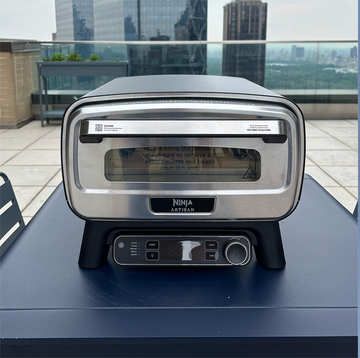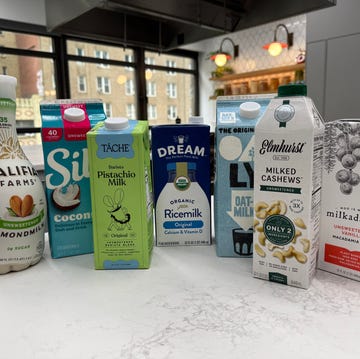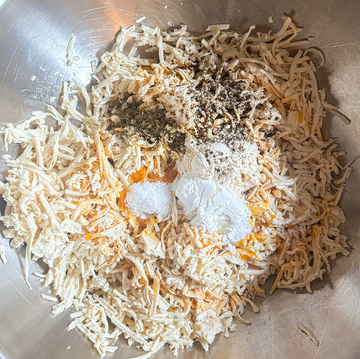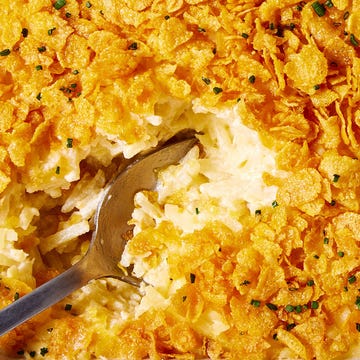The United States is a sprawling country with global influences, so it's no wonder that each region has its own culinary traditions. From early colonial recipes to dishes brought and adapted by immigrants, there are plenty of American delicacies that you can’t find anywhere else.
If you ever find yourself on a road trip or visiting an unfamiliar corner of the country, your trip would be remiss without tasting some local specialties. Famous foods like Texas barbecue and New York pizza are no-brainers. But there are several other unique regional dishes that fly under the radar.
We consulted food and travel experts from across the country to find some of the most underrated regional dishes that every American should try at least once. From barbecue to baked goods to breakfast, we rounded up some iconic foods that belong on your culinary bucket list.
Texas: Kolaches
For travel writer, blogger, and native Texan Tess Arnold, kolaches are an underrated Southern specialty. Not to be confused with the traditional Czech sweet kolach, the Texas version was brought to the U.S. by Czech immigrants. This breakfast pastry features the same sweet enriched dough used in Eastern Europe, but the fillings usually veer in the savory direction.
"The most common variation is filled with sausage and cheese, but you can find other options like jalapeno sausage, Ranchero, and my favorite, bacon, egg, and cheese," Arnold says. "You can find Kolaches at most donut shops throughout Texas and some surrounding states like Louisiana, but my favorite place for Kolaches is at Morning Kolaches in Deer Park, Texas."
Minnesota: Hot Beef Sandwiches
The Midwest is the land of meat and potatoes, and few regional specialties capture that spirit quite like Minnesota’s hot beef sandwiches, also known as a hot beef commercial. This diner classic’s origins are purported to be in Minnesota cities, where business travelers would stop by for a hearty meal before hopping on the train home.
"You want Grandma's recipe that's made with scratch gravy, tender in-house roast beef, and real mashed potatoes," says Nicole Johnson, Food Blogger & Recipe Developer at OrWhateverYouDo.com. When you’re on the hunt for a hot beef commercial, look for a restaurant with counter service complete with spinning stools. "If the person working the counter isn't at least 70, find another spot," Johnson advises. And if you want to be extra decadent, you can order it the same way she does—with fries instead of mashed potatoes and extra gravy.
Washington: Chicken Teriyaki
"Teriyaki is something that most people don’t typically associate with the PNW and Seattle, but Seattle-style chicken teriyaki is a must-have," says Megan Keno, food blogger, author, and finalist on season 4 of Next Level Chef. The region’s robust Japanese-American community ushered in plenty of the nation’s food traditions, which is why teriyaki became popularized in the 1970s. You can typically find the dish served in a three-compartment clamshell container, along with rice and an iceberg lettuce salad.
What makes Seattle-style sauce distinct is that it’s "much thinner in consistency than other national brands that are far more thick and sticky," Keno says. "The ingredients are simple, but it’s the double dose of marinating the chicken, and then the teriyaki sauce on top of chargrilled chicken that just makes this a flavor overload." The original Seattle-style teriyaki can be found at Toshi’s Teriyaki Grill in Mill Creek, but Keno also recommends stopping by Grillbird Teriyaki.
California: Santa Maria Tri-Tip
There are beloved dishes from almost every corner of California, but one state specialty is often overlooked. The Santa Maria Valley in California’s Central Coast has a longstanding tradition of barbecue, pioneered by ranchers and vaqueros of Spanish descent. And there’s one hallmark dish that defines the regional barbecue style.
"So many people think barbecue is all brisket or ribs, but tri-tip is a superstar cut that really encapsulates the flavor, technique, and history of this region," says Erica Blaire Roby, award-winning pitmaster. "Santa Maria tri-tip is a flavor-forward, medium-rare cut of beef that’s typically simply seasoned with a mixture of black pepper, garlic, and salt, then slowly grilled over native coastal live oak coals, commonly referred to as 'red oak,' until it’s perfectly tender and juicy."
The savory, smoky tri-tip is commonly topped with pico de gallo and served with local pinquito beans, green salad, and buttery grilled garlic bread. If you want to try some of the state’s finest Santa Maria tri-tip, Roby recommends stopping by the landmark restaurant Far Western Tavern, which she describes as "a must-visit for anyone who wants to appreciate a rich piece of Southern California’s barbecue history."
Vermont: Red Flannel Hash
Vermonters wear a lot of flannel, so it’s no surprise that one of the state’s signature dishes is named after the fabric. Red Flannel Hash is similar to a classic corned beef hash, but with one notable addition: beets. "The beets give it both its signature color and a slightly earthy sweetness that balances the savory elements," says Matthew McClure, Executive Chef and Director of Food and Beverage at Woodstock Inn and Resort.
Legend has it that Red Flannel Hash was a staple dish for the Green Mountain Boys during the Revolutionary War (though the dish may have emerged much later, in the late 19th or early 20th century, as a way to use up leftovers). Even now, it remains a quintessential dish in Vermont and New England at large. You can find it at diners and other breakfast spots all over the state—it’s absolutely worth waking up early for a plate.
Georgia: Lemon Pepper Wet Wings
Lemon pepper is a classic seasoning at any wing spot, but Georgia does it a little differently. Lemon pepper wings were popularized in Atlanta before they spread nationwide, but locals take the seasoning a step further by ordering their wings "wet"—that is, tossed in both lemon pepper seasoning and a buttery Buffalo-style hot sauce.
"It’s equal parts sharp citrus, peppery heat, and indulgent richness—deeply satisfying and totally unique to Atlanta," says Marissa Stevens, recipe developer and founder of Pinch and Swirl. "It's got its own cult following for a reason."
The city’s most iconic institution is J.R. Crickets, which is believed to be the birthplace of lemon pepper wet. American Deli is similarly beloved, but Stevens has another unconventional recommendation. "If you're in the mood for an experience, Magic City Kitchen (yes, inside the strip club) is unexpectedly known for having some of the best in town."
Pennsylvania: Dutch Chicken Pot Pie
The state of Pennsylvania owes many of its cultural traditions to the Pennsylvania Dutch, who started populating the region as early as the 17th century. Their cuisine in particular is one of the most notable contributions, like scrapple, shoofly pie, and apple dumplings. But the Pennsylvania Dutch chicken pot pie is one of the more underrated dishes.
"It originated with the Pennsylvania Dutch and Swiss communities and is essentially a hearty chicken stew made with vegetables, potatoes, and square egg noodles," says Chef Nuwan Karunarathna, Executive Chef at the Broad Table Tavern. The egg noodles, a hallmark ingredient of this regional cuisine, are what really make this dish special.
"It’s packed with the comforting, aromatic flavors of herb-infused chicken stock, tender vegetables, moist chicken, and homemade dough squares," he says. If you want to taste it for yourself, Karunarathna recommends stopping by the Dutch Eating Place in Philadelphia.
New Mexico: Frito Pie
Those from the Southwest are probably already familiar with Frito Pies, or walking tacos, but New Mexico’s version is distinct. It all comes down to the chile (not chili); the state’s iconic Hatch chile is the foundation of its cuisine and is often served as a gravy-like sauce in red and green varieties.
A New Mexican Frito Pie is built with beans, meat, cheese, lettuce, onion, tomato, and your choice of chile (pro tip: choose both, known in the state as Christmas). And of course, the whole thing is topped with plenty of crispy, salty Fritos. Some Delish staff favorites come from Five & Dime General Store in Santa Fe and Orlando’s in Taos.
Connecticut: Mashed Potato Pizza
Pizza lovers likely already know that New Haven, Connecticut, has one of the best regional pizza styles in the country. White clam pies may be known outside of the state, but there’s another unconventional topping that flies under the radar: mashed potatoes. Bar in New Haven pioneered the pizza over 30 years ago, and it remains a staple menu item to this day.
True to New Haven style, the mashed potato pizza has a thin, crispy, coal-fired crust. The white pie is scattered with chunky mashed potato, mozzarella, and, in many cases, bacon. Despite the starch-on-starch, the mashed potato pizza is surprisingly light. A few other places have thrown their hat into the ring with their own versions, but you should first stop at Bar for the original.
Louisiana: Sno-Balls
There’s no shortage of sweet treats in New Orleans. But aside from the classic plate of beignets or bananas foster, there’s one cult-favorite dessert that screams Louisiana. Sno-balls (or snowballs, depending on who you ask) are just like your favorite snow cone—but better. Unlike the standard coarse granules, sno-balls are created with thinly shaved ice that creates a particularly soft, pillowy texture.
The syrups vary depending on where you go, but you can expect some that go beyond your classic blue raspberry. From satsuma to sweet tea to café "sno-lait," there’s a fun flavor for everyone. You can find sno-balls all across New Orleans, but our team’s favorite is Hansen’s Sno-Bliz (the founder invented the shaved ice machine, after all).
New York: Garbage Plate
New York is known for its pizza, bagels, and cheesecake. But to experience the Empire State’s most iconic delicacy, you need to head north to Rochester for a garbage plate. This dish looks as messy as the name suggests and is extremely customizable. First you choose your base: a cheeseburger, hamburger, hot dogs, Italian sausage, chicken, or a grilled cheese. Then you choose any combination of your preferred accompaniments (typically home fries, french fries, baked beans, and macaroni salad).
And as if that wasn’t enough, garbage plates are usually topped with a hot meat sauce that resembles chili and served with a side of bread. Optional toppings include ketchup, mustard, and onions. It’s abundant, it’s sloppy, and it’s glorious. To get the most authentic experience, go to Nick Tahou Hots for the original (and trademarked) garbage plate.
Nebraska: Cheese Frenchee
If you’ve been to any state fair in the Midwest, you know that they love all things fried. Nebraska is no exception, which explains why one of the state’s most iconic delicacies is a cheese frenchee—A.K.A. a deep-fried grilled cheese sandwich. The Cheese Frenchee was first invented at the now-defunct chain King’s Food Host in the 1950s. The "frenchee" comes from its resemblance to the French croque monsieur (but the connection to the European sandwich is flimsy at best).
It’s simple, but unsurprisingly delicious. Imagine a basic grilled cheese with white sandwich bread, American cheese, and maybe a little mayonnaise. The sandwich is cut into triangles, battered, and coated in crushed cornflakes or saltines before hitting the deep fryer. The result is crispy, melty, and decadent. You may not be able to go to the original King’s Food Host, but you can get great Cheese Frenchees at Don & Millie’s.


















